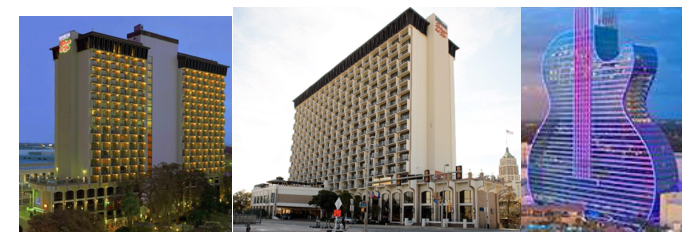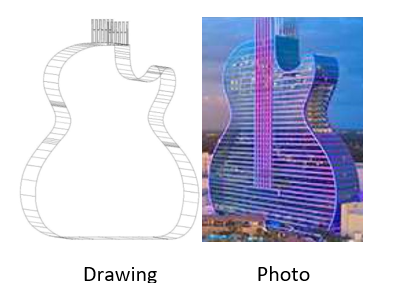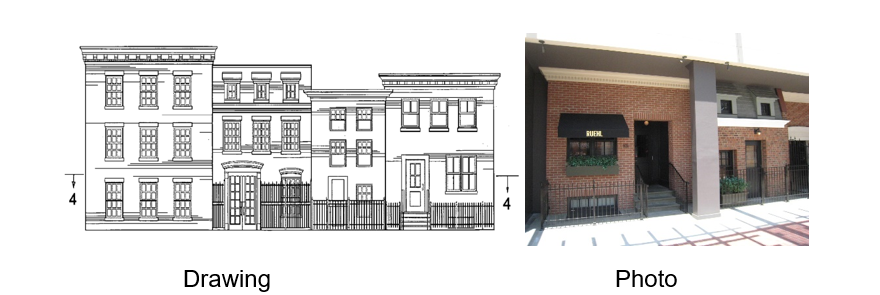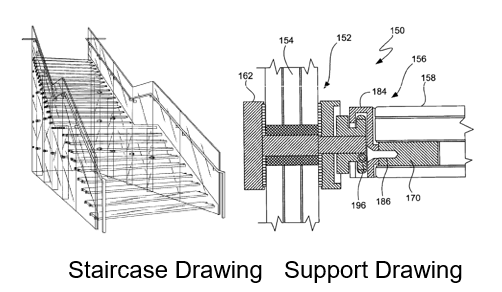Hospitality Industry Insight: Is Your Hotel or Restaurant’s Exterior Design Protectable Against Imitation or Unauthorized Use?
In addition to registering a hotel or restaurant’s name as a service mark, it may be possible to protect its exterior design from unauthorized use or copying by others for the same or similar services--if the design is sufficiently distinctive to qualify for a service mark registration.
Two illustrative precedential decisions about service mark applications to register the trade dress of hotel buildings, with differing outcomes, were issued by the Trademark Trial and Appeal Board (TTAB) on the same day.

1. Palacio Del Rio Building is not registrable as a Service Mark
Palacio Del Rio, Inc. filed separate applications to register three-dimensional line drawings of the front and rear views of its hotel in San Antonio, Texas as service marks for hotel services.

The Examining Attorney refused registration on the grounds that the marks consisted of nondistinctive trade dress and that the Applicant’s evidence of acquired distinctiveness was insufficient. The Applicant appealed to the TTAB. The TTAB affirmed the refusals to register these marks.
The TTAB found that these hotel designs were not inherently distinctive because they:
1) constituted common basic design elements. The evidence showed many hotels having those elements. Also, declarations from four customers were not probative because they were few, identical and conclusory.
2) did not make a commercial impression distinct from the accompanying hotel name. The record did not show that the Applicant had promoted or emphasized its building designs separate and apart from the hotel’s name.
The TTAB also found that these hotel designs had not acquired distinctiveness because the Applicant’s advertising did not direct attention to the hotel designs as source indicators, the sales numbers did not provide any market share context, and unsolicited articles discussed the hotel’s innovative construction techniques rather than its trade dress.
Accordingly, these hotel designs were not registrable as service marks.
In re Palacio Del Ruio, Inc., Application Nos. 88412764 and 88437801 (T.T.A.B. May 25, 2023)
2. Seminole Hard Rock Building is registrable as a Service Mark
The Seminole Tribe of Florida applied to register a three-dimensional line drawing of its guitar-shaped Hard Rock hotel in Hollywood, Florida as a service mark for casinos, hotel, restaurant, and bar services.

The Examining Attorney refused registration on the grounds that the mark consisted of nondistinctive trade dress, failed to function as a service mark, and had not acquired distinctiveness. The TTAB reversed solely on the ground that the mark was inherently distinctive.
The TTAB accepted the Examining Attorney’s argument that buildings come in all shapes and sizes and have common elements. But the record in this case lacked any evidence showing that anyone in the U.S. other than Applicant had adopted a “guitar design” trade dress for a building. The TTAB found that this was neither a common design nor a mere refinement of a commonly adopted and well-known form of ornamentation for Applicant’s services.
Accordingly, this hotel design was registrable as a service mark.
In re Seminole Tribe of Florida, Application No. 87892892 (T.T.A.B. May 25, 2023)
Takeaways
If you want to obtain a registration for the exterior design of a hotel or restaurant, you should be prepared to show:
EITHER
1. inherent distinctiveness because it is:
- not a common basic shape or design,
- an unusual design,
- not a mere refinement of a commonly adopted and well-known ornamentation, and
- capable of creating a commercial impression distinct from the accompanying words (for example, by highlighting “Look for” the shape or design in advertising and promotion in a manner separate from the hotel name);
OR
2. acquired distinctiveness (secondary meaning) considering:
- consumer association with a particular source (such as by a consumer survey),
- the length, degree, and exclusivity of use,
- the amount and manner of advertising in the context of industry comparisons,
- the amount of sales and number of customers in the context of market share,
- intentional copying, if any, and
- unsolicited media coverage mentioning the trade dress for the services.
Author’s Note:
Copyright
You may wish to consider applying to register a copyright in the “architectural work” embodied in the building. This applies only to buildings constructed on or after December 1, 1990, when the Copyright Act was amended to add “architectural works,” defined as “the design of a building as embodied in any tangible medium of expression, including a building, architectural plans, or drawings,” to the categories of protected works of authorship. (Emphasis added.)
Keep in mind these important limitations:
- The copyright in an architectural work is not applicable to functional or standard building features.
- In the absence of an assignment, the architectural firm remains the copyright owner of the architectural work, and the hotel or restaurant may only have a non-exclusive license to use the design for that one project, depending on the agreement between the parties.
- If the building is visible from a public space, anyone is free to make, distribute or display photographs or other pictorial representations of it.
- Despite the copyright, the owner of a building may destroy the building without the consent of the copyright owner.
Patent
You also may consider applying for a design patent covering the new, original, and ornamental (non-functional) look of a building, if it was completed within the year before the patent application is filed. Below is an example of Design Patent D557,818 for Abercrombie & Fitch Trading Co.’s Ruehl storefront:

Sometimes a design patent may be combined with a utility patent covering novel and non-obvious functional features of a building. Below are examples of Design Patent D478,999 for Apple Inc. glass staircase, and Utility Patent 7,165,362 for its support mechanism:

Keep in mind that in the United States, in the absence of assignments, the individual designers are considered the “inventors” and owners of the design. Therefore, it is important to get a written assignment of any patent rights from the designers to the company.
Experienced intellectual property counsel can advise you as to whether one or more of these types of protection may be applicable to your hotel or restaurant’s exterior design or its features.
For more information, please contact Joel Karni Schmidt or your CLL attorney.

Partner
Email | 212.790.9244
Joel is a member of our firm’s Executive Committee and has handled intellectual property counseling, protection, and enforcement matters for over 20 years. He has extensive experience managing worldwide trademark, copyright, and domain name programs, litigations and proceedings, and resolving complex problems and disputes.